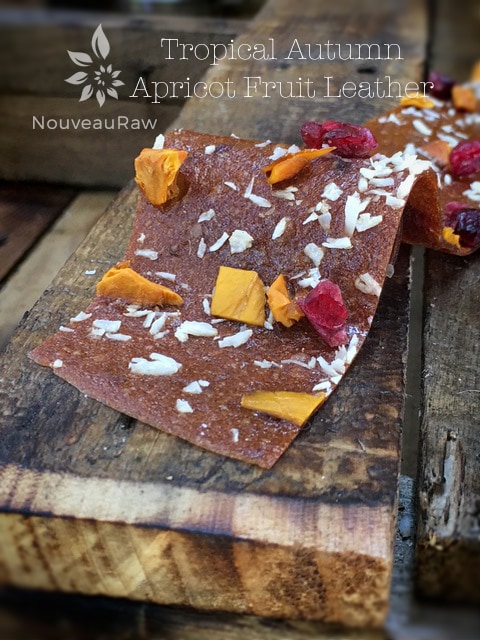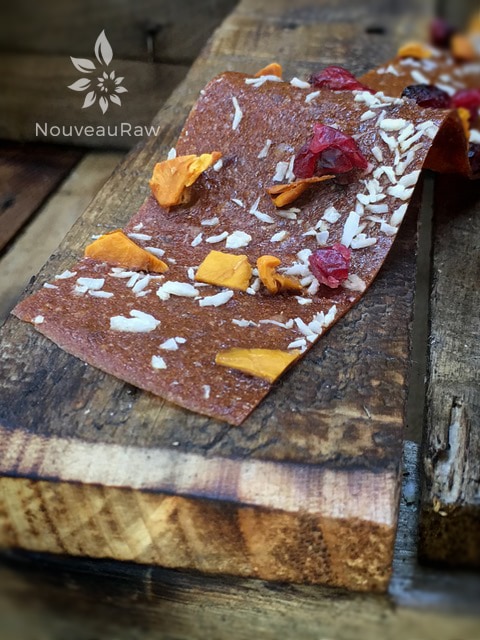Tropical Autumn Apricot Fruit Leather

 Add to favorites
Add to favorites

~ raw, gluten-free, nut-free ~
When apricots are ripe, their sweetness offsets their mouth-puckering tanginess. That tangy flavor allows apricots to mix equally well into sweet or savory dishes.
So that brought Cardamom to mind, which offers a complex, savory flavor profile. The seeds of this East Indian plant are so heavily fragrant that perfumers use them to give their scents a warm, resinous aroma.
The seeds taste as pleasant as they smell and enhance both the sweetness and the tartness of fresh apricot. But, use a light hand when adding cardamom to your recipe. It is a strong spice.
Ingredients:
yields 4 1/2 cups puree
- 5 cups sliced apricot
- 1 cup organic pumpkin puree
- 2 Tbsp raw honey
- 2 Tbsp chia seeds, ground in spice grinder
- 2 tsp vanilla extract
- 1/2 tsp ground Ceylon cinnamon
- 1/4 tsp ground cardamom
- 1/4 tsp liquid stevia
- 1/8 tsp Himalayan pink salt
- 1 cup coconut flakes (sprinkled on wet leather)
Preparation:
- Select RIPE or slightly overripe apricots that have reached a peak in color, texture, and flavor.
- Prepare the apricots; wash, dry, and remove stones.
- Puree the apricots, honey, chia seeds, vanilla, cinnamon, cardamom, and salt, in the blender or food processor until smooth. Taste and sweeten more if needed. Keep in mind that flavors will intensify as they dehydrate. When adding a sweetener do so 1 tbsp at a time, and reblend, tasting until it is at the desired taste. It is best to use a liquid type sweetener. Don’t use granulated sugar because it tends to change the texture.
- Allow the puree to sit for 10 minutes, so the chia has time to thicken the puree.
 Spread the fruit puree on teflex sheets that come with your dehydrator. Pour the puree to create an even depth of 1/8 to 1/4 inch. If you don’t have teflex sheets for the trays, you can line your trays with plastic wrap or parchment paper. Do not use wax paper or aluminum foil.
Spread the fruit puree on teflex sheets that come with your dehydrator. Pour the puree to create an even depth of 1/8 to 1/4 inch. If you don’t have teflex sheets for the trays, you can line your trays with plastic wrap or parchment paper. Do not use wax paper or aluminum foil.
- Lightly coat the food dehydrator plastic sheets or wrap with a cooking spray, I use coconut oil that comes in a spray.
- When spreading the puree on the liner, allow about an inch of space between the mixture and the outside edge. The fruit leather mixture will spread out as it dries, so it needs a little room to allow for this expansion.
- Be sure to spread the puree evenly on your drying tray. When spreading the puree mixture, try tilting and shaking the tray to help it distribute more evenly. Also, it is a good idea to rotate your trays throughout the drying period. This will help assure that the leathers dry evenly.
- Dehydrate the fruit leather at 145 degrees (F) for 1 hour, reduce temp to 115 degrees (F) and continue drying for about 16 (+/-) hours. Flip the leather over about halfway through, remove the teflex sheet, and continue drying on the mesh sheet. The finished consistency should be pliable and easy to roll.
- Check for dark spots on top of the fruit leather. If dark spots can be seen it is a sign that it is not completely dry.
- Press down on the fruit leather with a finger. If no indentation is visible or if it is no longer tacky to the touch, the fruit leather is dry and can be removed from the dehydrator.
- Peel the leather from the dehydrator trays or parchment paper. If it peels away easily and holds its shape after peeling, it is dry. If it is still sticking or loses its shape after peeling, it needs further drying.
- Under-dried fruit leather will not keep; it will mold. Over-dried fruit leather will become hard and crack, although it will still be edible and will keep for a long time
- Storage: To store the finished fruit leather…
- Allow the leather to cool before wrapping up to avoid moisture from forming, thus giving it a breeding ground for molds.
- Roll them up and wrap them tightly with plastic wrap. Click (here) to see photos of how I wrap them.
- Place in an air-tight container, and store in a dry, dark place. (Light will cause the fruit leather to discolor.)
- The fruit leather will keep at room temperature for one month, or in a freezer for up to one year.
Culinary Explanations:
- Why do I start the dehydrator at 145 degrees (F)? Click (here) to learn the reason behind this.
- When working with fresh ingredients, it is important to taste test as you build a recipe. Learn why (here).
- Don’t own a dehydrator? Learn how to use your oven (here). I do however truly believe that it is a worthwhile investment. Click (here) to learn what I use.
© AmieSue.com
Tags: Dairy Free, Gluten Free, Nut Free, Refined Sugar Free, Vegan



 Add to favorites
Add to favorites
 Spread the fruit puree on teflex sheets that come with your dehydrator. Pour the puree to create an even depth of 1/8 to 1/4 inch. If you don’t have teflex sheets for the trays, you can line your trays with plastic wrap or parchment paper. Do not use wax paper or aluminum foil.
Spread the fruit puree on teflex sheets that come with your dehydrator. Pour the puree to create an even depth of 1/8 to 1/4 inch. If you don’t have teflex sheets for the trays, you can line your trays with plastic wrap or parchment paper. Do not use wax paper or aluminum foil.